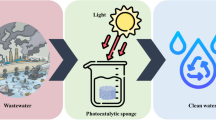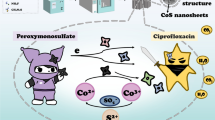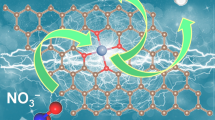Abstract
Immobilization of the Geotrichum candidum (CCT 1205) cell with functionalized silica creates promising biocatalysts for production of ɛ-caprolactone. The results obtained by immobilization of the whole cell on SiO2-NH2 and SiO2-SH supports indicate that the presence of reactive functional groups on the support may promote effective chemical bonds with the cell walls resulting the decreased dehydrogenases enzyme activity (5% yield in less than 2h) and consequently, increased Baeyer-Villiger monooxygenases enzyme activity with redacting of 25% of time reaction when is used SiO2-NH2 as support and 50% through use of SiO2-SH as support relative to free cells when cyclohexanone is used as a substrate. The catalysts SiO2–NH2–Geotrichum candidum and SiO2–SH–Geotrichum candidum were recycling and reused in the ɛ-caprolactone synthesis from cyclohexanone, and the biocatalysts promoted a quantitative conversion up to the eighth reaction cycle.
Key points
• Immobilized microorganism is more efficient than free cell in the caprolactone synthesis.
• The reaction times for amino and thiol groups in support were 3 h and 2 h, respectively.
• These catalysts showed higher ɛ-caprolactone conversion at higher concentrations.








Similar content being viewed by others
References
Alphand V, Carrea G, Wohlgemuth R, Furstoss R, Woodley JM (2003) Towards large-scale synthetic applications of Baeyer-Villiger monooxygenases. Trends Biotechnol 21:318–323. https://doi.org/10.1016/s0167-7799(03)00144-6
Auler LM, Silva CR, Collins KE, Collins CH (2005) New stationary phase for anion-exchange chromatography. J Chromatogr A 1073:147–153. https://doi.org/10.1016/j.chroma.2004.10.012
Bergna HE, Roberts WO (2005) Colloidal silica: fundamentals and applications, vol 131. CRC Press, New York, 465-499 pp.
Bornadel A, Hatti-Kaul R, Hollmann F, Kara S (2016) Enhancing the productivity of the bi-enzymatic convergent cascade for ɛ-caprolactone synthesis through design of experiments and a biphasic system. Tetrahedron 72:7222–7228. https://doi.org/10.1016/j.tet.2015.11.054
Bučko M, Gemeiner P, Schenkmayerová A, Krajčovič T, Rudroff F, Mihovilovič MD (2016) Baeyer-Villiger oxidations: biotechnological approach. Appl Biochem Biotechnol 100:6585–6599. https://doi.org/10.1007/s00253-016-7670-x
Carballeira JD, Álvarez E, Sinisterra JV (2004) Biotransformation of cyclohexanone using immobilized Geotrichum candidum NCYC49: factors affecting the selectivity of the process. J Mol Catal B Enzym 28:25–32. https://doi.org/10.1016/j.molcatb.2004.01.009
Fried J, Thoma RW, Klingsberg A (1953) Oxidation of steroids by micro örganisms. Iii. Side chain degradation, ring d-cleavage and dehydrogenation in ring a. J Am Chem Soc 75:5764–5765. https://doi.org/10.1021/ja01118a530
Hudlicky T, Reed JW (2009) Applications of biotransformations and biocatalysis to complexity generation in organic synthesis. Chem Soc Rev 38:3117–3132. https://doi.org/10.1039/b901172m
Khdary NH, Ghanem MA (2012) Metal–organic–silica nanocomposites: copper, silver nanoparticles–ethylenediamine–silica gel and their CO2 adsorption behaviour. J Mater Chem 22:12032–12038. https://doi.org/10.1039/c2jm31104f
Kisukuri CM, Andrade LH (2015) Production of chiral compounds using immobilized cells as a source of biocatalysts. Org Biomol Chem 13:10086–10107. https://doi.org/10.1039/c5ob01677k
Labet M, Thielemans W (2009) Synthesis of polycaprolactone: a review. Chem Soc Rev 38:3484–3504. https://doi.org/10.1039/B820162P
Lee WH, Park YC, Lee DH, Park K, Seo JH (2005) Simultaneous biocatalyst production and Baeyer-Villiger oxidation for bioconversion of cyclohexanone by recombinant Escherichia coli expressing cyclohexanone monooxygenase. Appl Biochem Biotechnol 123(1):827–836. https://doi.org/10.1385/abab:123:1-3:0827
Lee WH, Park JB, Park K, Kim MD, Seo JH (2007) Increased production of ɛ-caprolactone by overexpression of NADPH-regenerating glucose-6-phosphate dehydrogenase in recombinant Escherichia coli containing the cyclohexanone monooxygenase gene. Appl Biochem Biotechnol 76:329–338. https://doi.org/10.1007/s00253-007-1016-7
Mallin H, Wulf H, Bornscheuer UT (2013) A self-sufficient Baeyer–Villiger biocatalysis system for the synthesis of ɛ-caprolactone from cyclohexanol. Enzym Microb Technol 53:283–287. https://doi.org/10.1016/j.enzmictec.2013.01.007
Mandal D, Ahmad A, Khan MI, Kumar R (2002) Biocatalytic transformation of cyclohexanone by Fusarium sp. J Mol Catal A Chem 181:237–241. https://doi.org/10.1016/s1381-1169(01)00368-5
Martínez I, Zhu J, Lin H, Bennett GN, San KY (2008) Replacing Escherichia coli NAD-dependent glyceraldehyde 3-phosphate dehydrogenase (GAPDH) with a NADP-dependent enzyme from Clostridium acetobutylicum facilitates NADPH dependent pathways. Metab Eng 10:352–359. https://doi.org/10.1016/j.ymben.2008.09.001
Mirza IA, Yachnin BJ, Wang S, Grosse S, Bergeron H, Imura A, Berghuis AM (2009) Crystal structures of cyclohexanone monooxygenase reveal complex domain movements and a sliding cofactor. J Am Chem Soc 131:8848–8854. https://doi.org/10.1021/ja9010578
Mthethwa KS, Kassier K, Engel J, Kara S, Smit MS, Opperman DJ (2017) Fungal BVMOs as alternatives to cyclohexanone monooxygenase. Enzym Microb Technol 106:11–17. https://doi.org/10.1016/j.enzmictec.2017.06.017
Parra LP, Acevedo JP, Reetz MT (2015) Directed evolution of phenylacetone monooxygenase as an active catalyst for the Baeyer–Villiger conversion of cyclohexanone to caprolactone. Biotechnol Bioeng 112:1354–1364. https://doi.org/10.1002/bit.25564
Qiu H, Jiang Q, Wei Z, Wang X, Liu X, Jiang S (2007) Preparation and evaluation of a zwitterionic stationary phase of 1-alkyl-3- (propyl-3-sulfonate) imidazole based on silica for high performance liquid chromatography. J Chromatogr A 1163:63–69. https://doi.org/10.3390/ijms10062591
Rebroš M, Lipták L, Rosenberg M, Bučko M, Gemeiner P (2014) Biocatalysis with Escherichia coli-overexpressing cyclopentanone monooxygenase immobilized in polyvinyl alcohol gel. Lett Appl Microbiol 58:556–563. https://doi.org/10.1111/lam.12227
Romero E, Castellanos JRG, Mattevi A, Fraaije MW (2016) Characterization and crystal structure of a robust cyclohexanone monooxygenase. Angew Chem Int Ed 55:15852–15855. https://doi.org/10.1002/ange.201608951
Schenkmayerová A, Bučko M, Gemeiner P, Chorvát D, Lacík I (2012) Viability of free and encapsulated Escherichia coli overexpressing cyclopentanone monooxygenase monitored during model Baeyer–Villiger biooxidation by confocal laser scanning microscopy. Biotechnol Lett 34:309–314. https://doi.org/10.1007/s10529-011-0765-7
Silva ALP, Batista PK, Filho AD, Junior CSDN, Rebouças JS, Vale JA (2017) Rapid conversion of cyclohexenone, cyclohexanone and cyclohexanol to ε-caprolactone by whole cells of Geotrichum candidum CCT 1205. Biocatal Biotransform 35:185–190. https://doi.org/10.1080/10242422.2017.1310207
Srinivasamurthy VST, Böttcher D, Engel J, Kara S, Bornscheuer UT (2020) A whole-cell process for the production of ε-caprolactone in aqueous media. Process Biochem 88:22–30. https://doi.org/10.1016/j.procbio.2019.10.009
Staudt S, Bornscheuer UT, Menyes U, Hummel W, Gröger H (2013) Direct biocatalytic one-pot-transformation of cyclohexanol with molecular oxygen into ɛ-caprolactone. Enzym Microb Technol 53:288–292. https://doi.org/10.1016/j.enzmictec.2013.03.011
Stergiou PY, Foukis A, Filippou M, Koukouritaki M, Parapouli M, Theodorou LG, Papamichael EM (2013) Advances in lipase-catalyzed esterification reactions. Biotechnol Adv 31:1846–1859. https://doi.org/10.1016/j.biotechadv.2013.08.006
Wachtmeister J, Rother D (2016) Recent advances in whole cell biocatalysis techniques bridging from investigative to industrial scale. Curr Opin Biotechnol 42:169–177. https://doi.org/10.1016/j.copbio.2016.05.005
Walcarius A, Etienne M, Bessière J (2002) Rate of access to binding sites in organically modified silicates. 1. Amorphous silica gels grafted with amine or thiol groups. Chem Mater 14:2757–2766. https://doi.org/10.1021/cm021117k
Walton AZ, Stewart JD (2002) An efficient enzymatic Baeyer–Villiger oxidation by engineered Escherichiacoli cells under non-growing conditions. Biotechnol Prog 18:262–268. https://doi.org/10.1021/bp010177c
Weiser D, Nagy F, Bánóczi G, Oláh M, Farkas A, Szilágyi A, Poppe L (2017) Immobilization engineering–how to design advanced sol–gel systems for biocatalysis? Green Chem 19:3927–3937. https://doi.org/10.1039/c7gc00896a
Yachnin BJ, Lau PC, Berghuis AM (2016) The role of conformational flexibility in the catalysis and structure of the Baeyer-Villiger monooxygenase. Biochim Biophys Acta Proteins Proteomics 1864:1641–1648. https://doi.org/10.1016/j.bbapap.2016.08.015
Zajkoska P, Rebroš M, Rosenberg M (2013) Biocatalysis with immobilized Escherichia coli. Appl Biochem Biotechnol 97:1441–1455. https://doi.org/10.1007/s00253-012-4651-6
Zucca P, Sanjust E (2014) Inorganic materials as supports for covalent enzyme immobilization: methods and mechanisms. Molecules 19:14139–14194. https://doi.org/10.3390/molecules190914139
Acknowledgements
We would like to acknowledge the Coordenação de Aperfeiçoamento de Pessoal de Nível Superior (CAPES) , Conselho Nacional de Desenvolvimento Científico e Tecnológico (CNPq) and Centro de Tecnologias Estratégicas do Nordeste (CETENE) for their financial support.
Funding
This work was supported by the CNPQ (No. 304403/2017-2).
Author information
Authors and Affiliations
Contributions
Juliana A. Vale conceived and designed research and the other authors conducted experiments.
Corresponding author
Ethics declarations
Conflict of interest
The authors declare that there are no conflicts of interest.
Ethics approval
This work does not involve any human participation or live animals performed by any of the listed authors.
Additional information
Publisher’s note
Springer Nature remains neutral with regard to jurisdictional claims in published maps and institutional affiliations.
Rights and permissions
About this article
Cite this article
Silva, A.L.P., da Silva Caridade, T.N., Magalhães, R.R. et al. Biocatalytic production of Ɛ-caprolactone using Geotrichum candidum cells immobilized on functionalized silica. Appl Microbiol Biotechnol 104, 8887–8895 (2020). https://doi.org/10.1007/s00253-020-10875-7
Received:
Revised:
Accepted:
Published:
Issue Date:
DOI: https://doi.org/10.1007/s00253-020-10875-7




